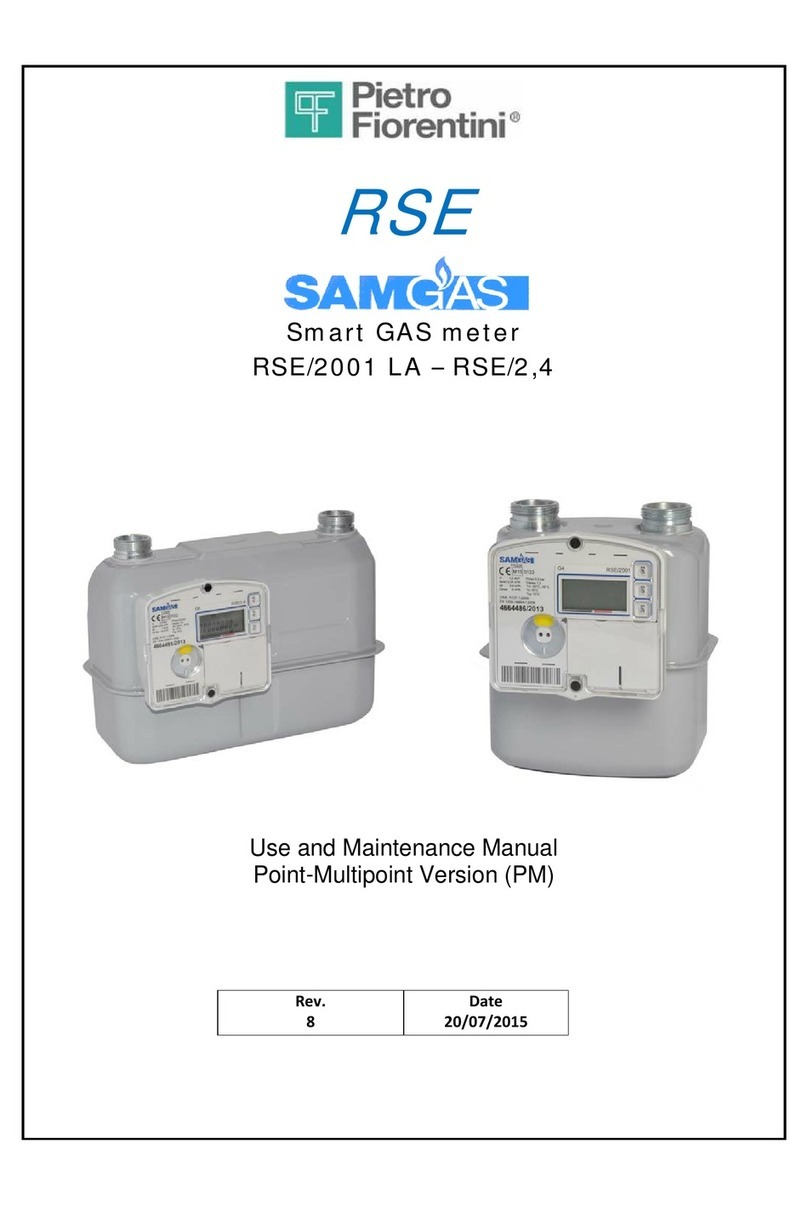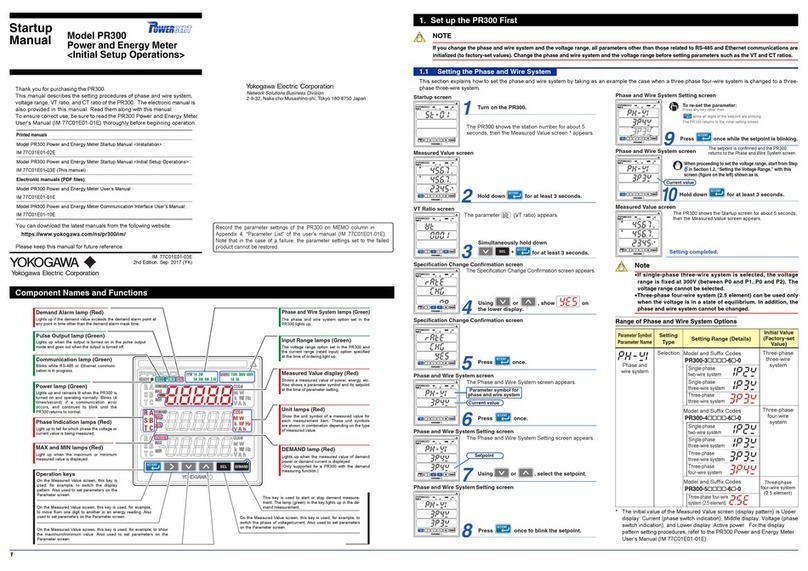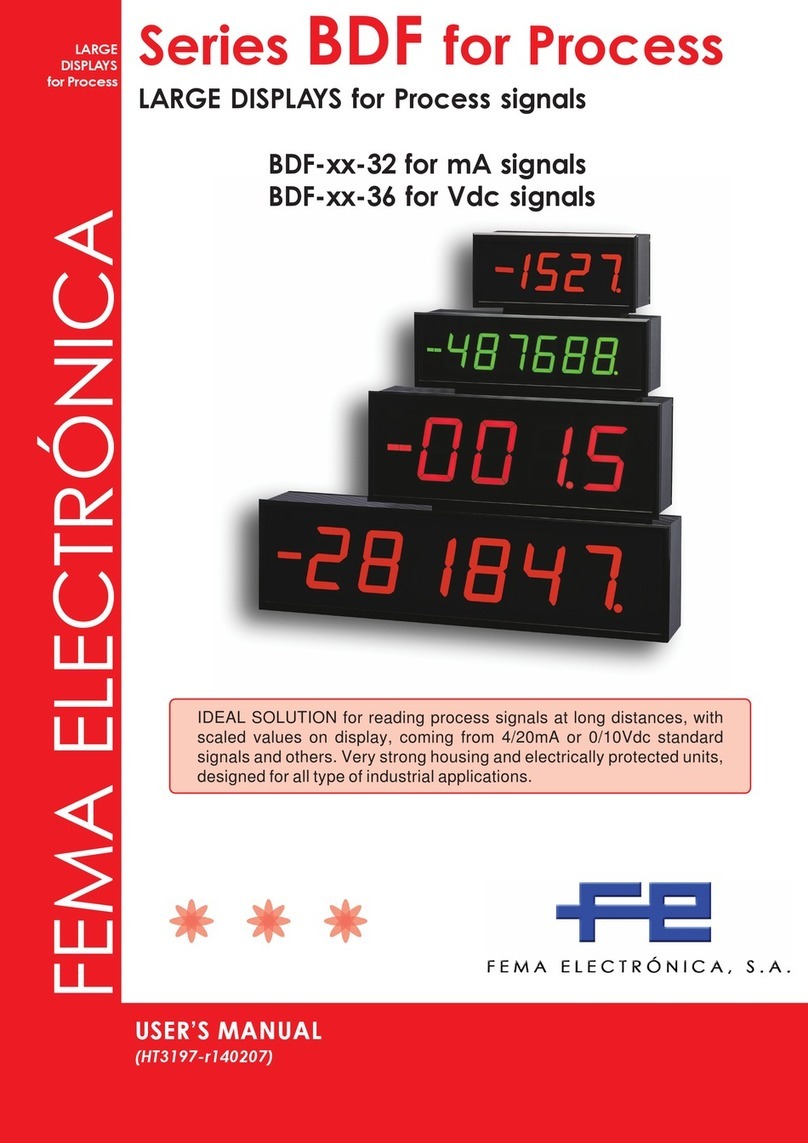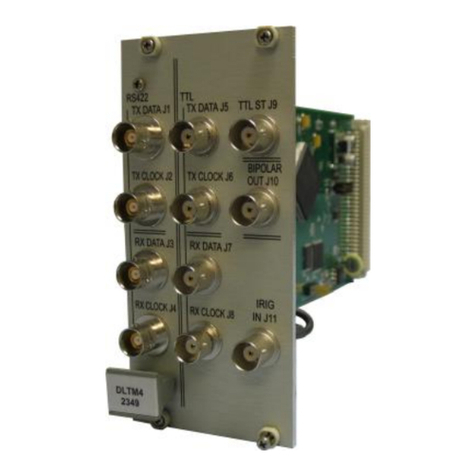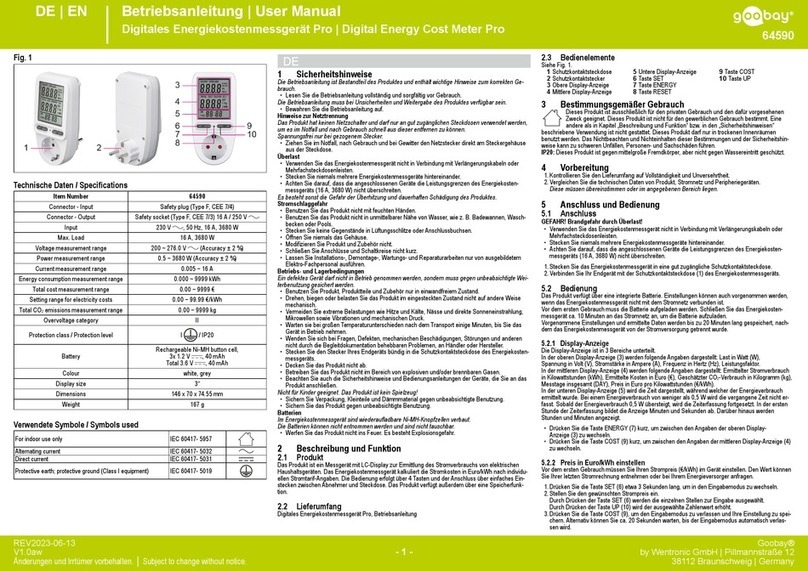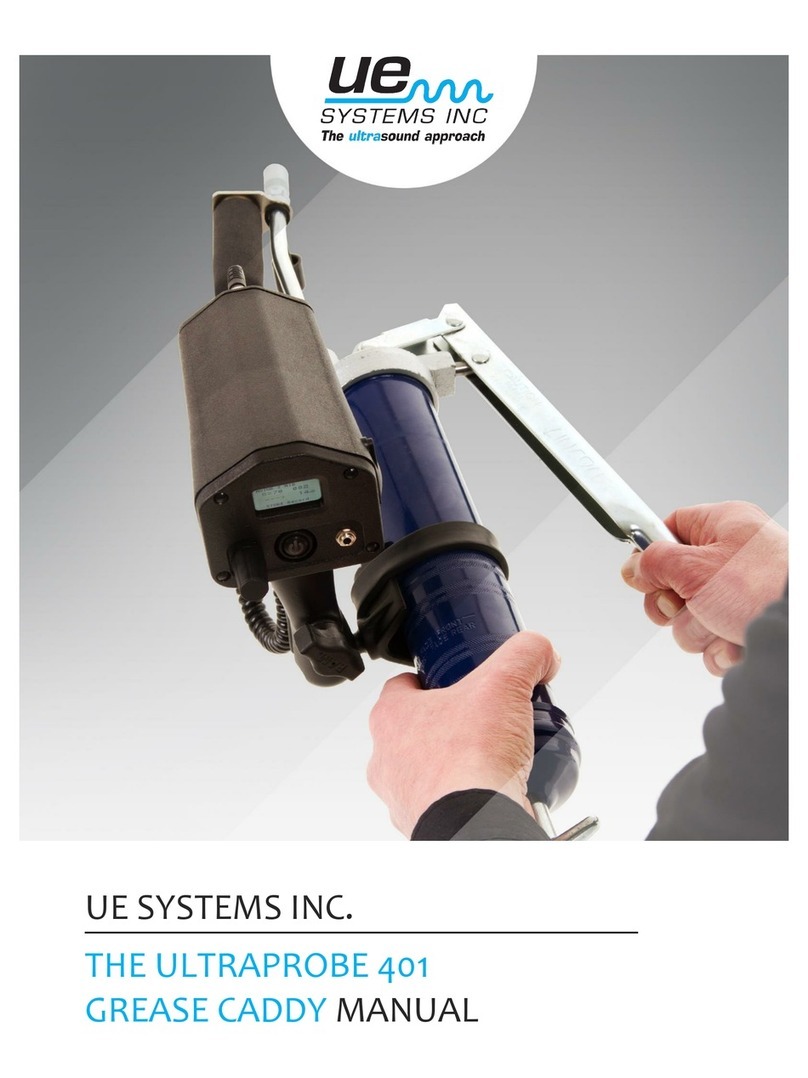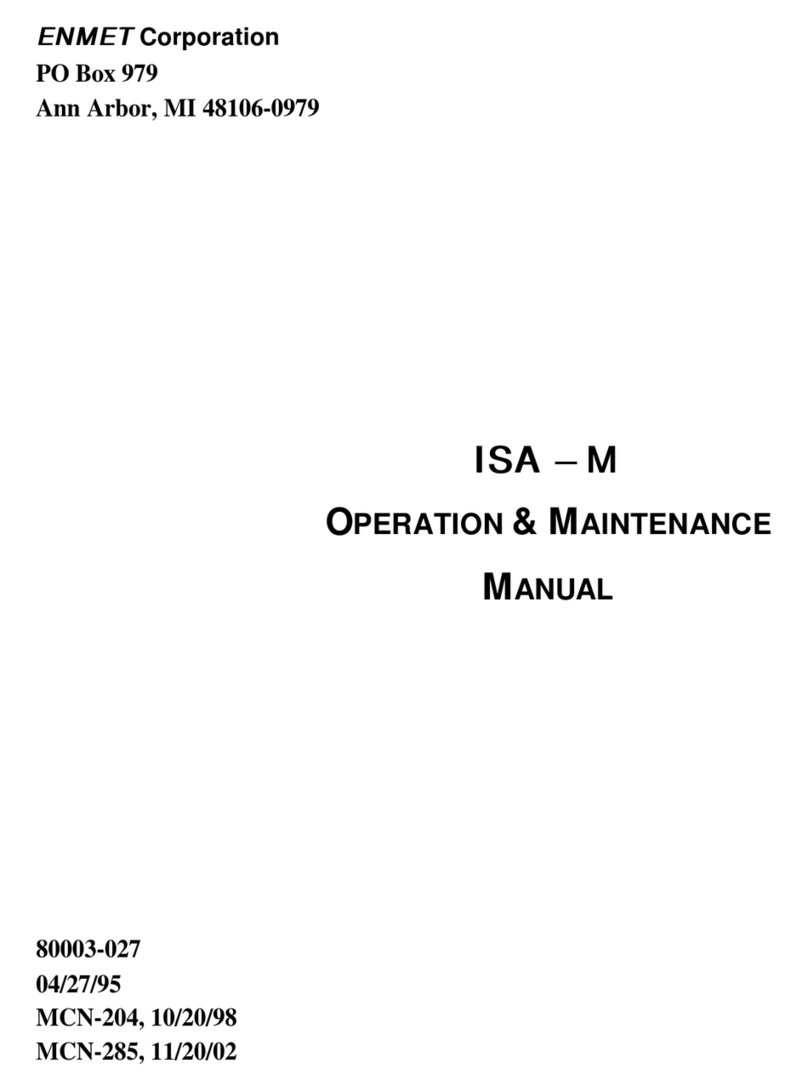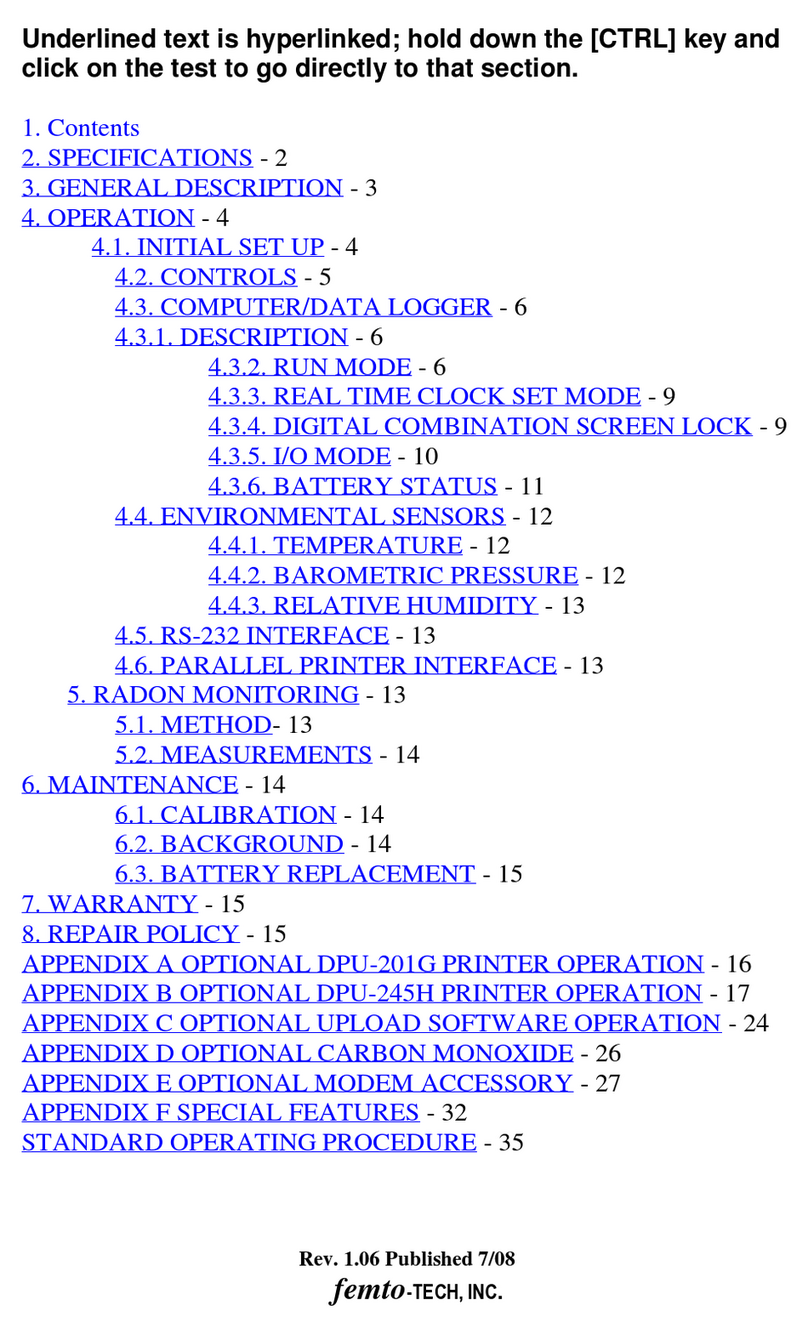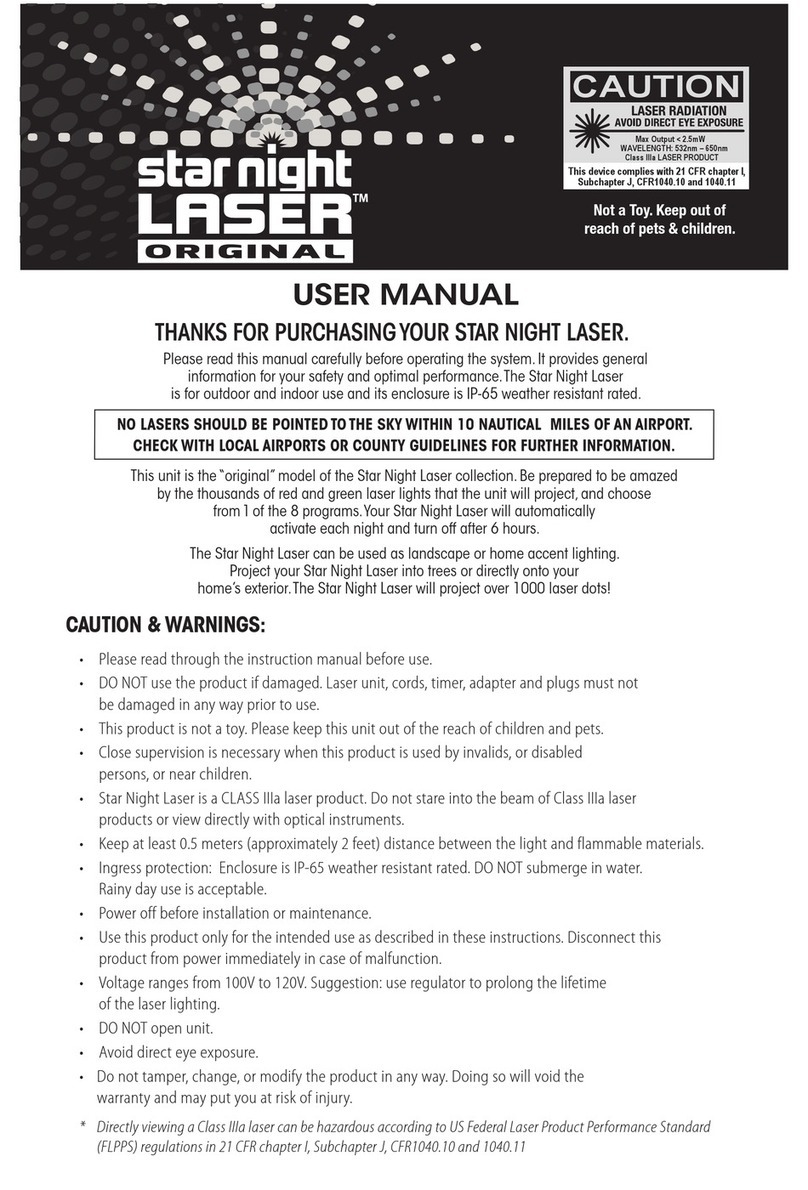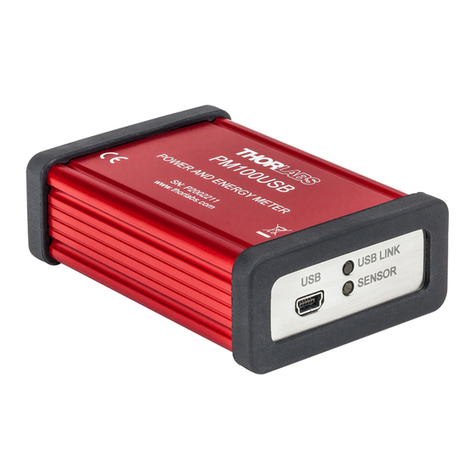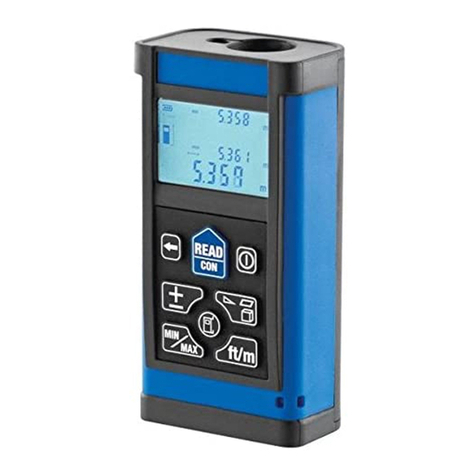General Monitors TS4000H User manual

The information and technical data disclosed in
this document may be used and disseminated
only for the purposes and to the extent
specifically authorized in writing by General
Monitors.
Instruction Manual 02-17
General Monitors reserves the right to change
published specifications and designs without
prior notice.
MANTS4000H
Part No. MANTS4000H
Revision P/02-17
Model TS4000H
Intelligent Sensor for
Toxic Gas Detection

TS4000H
ii
This page intentionally left blank.

TS4000H
iii
Table of Contents
TABLE OF FIGURES.................................................................................................................VII
TABLE OF TABLES..................................................................................................................VIII
ABOUT THIS MANUAL ...............................................................................................................1
Format Conventions................................................................................................................................1
Notes, Cautions, and Warnings .................................................................................................1
Menu Formats ............................................................................................................................1
Modbus Register Formats..........................................................................................................1
Other Sources of Help.............................................................................................................................1
Contacting Customer Support....................................................................................................1
1.0 BEFORE INSTALLATION......................................................................................................2
1.1 System Integrity Verification ......................................................................................................2
1.2 Commissioning Safety Systems ................................................................................................2
1.3 Notes and Warnings...................................................................................................................2
1.4 Glossary of Terms......................................................................................................................3
2.0 PRODUCT OVERVIEW..........................................................................................................6
2.1 General Description ...................................................................................................................6
2.2 Features and Benefits................................................................................................................6
2.3 Applications................................................................................................................................7
2.4 Base Unit....................................................................................................................................7
2.5 Interface Module ........................................................................................................................8
2.6 Electrochemical Cell.................................................................................................................10
3.0 INSTALLATION....................................................................................................................11
3.1 Unpacking the Equipment........................................................................................................11
3.2 Preparing for the Installation ....................................................................................................11
3.2.1 Required Tools............................................................................................................12
3.2.2 Detection Location Guidelines ....................................................................................12
3.3 Installation Overview................................................................................................................13
3.3.1 Intrinsic Safety Barrier.................................................................................................14
3.3.2 Electrochemical Cell Maintenance..............................................................................14
3.4 Mounting Instructions...............................................................................................................14
3.4.1 Mounting Dimensions..................................................................................................15
3.4.2 Mounting – Local Configuration ..................................................................................16
3.4.3 Mounting – Remote Configuration with External Junction Box...................................17
3.5 Wiring Connections..................................................................................................................18
3.5.1 Wiring Safety Notices..................................................................................................20
3.5.2 Base Unit Wiring .........................................................................................................21
3.5.3 Connecting to the Power Supply DC Ground .............................................................22
3.5.4 Connecting Control Room Devices to the TB1 Block .................................................23
3.5.5 Connecting to the +24 VDC Power Supply.................................................................24
3.5.6 Connecting Alarm Relay Devices to the TB3 Block....................................................25
3.6 Applying Power and Starting Operation...................................................................................26

TS4000H
iv
3.6.1 Start-up Readiness Checklist......................................................................................26
3.6.2 Start-up Process .........................................................................................................27
3.7 Maintaining Explosion Proof Integrity.......................................................................................27
4.0 OPERATION.........................................................................................................................29
4.1 Start-up Checklist.....................................................................................................................29
4.2 User Menu Structure................................................................................................................29
4.3 User Menu Display...................................................................................................................31
4.4 Start-up ....................................................................................................................................32
4.5 Using the Selection Magnet .....................................................................................................33
4.6 Selectable Options...................................................................................................................34
4.6.1 Sensor Range .............................................................................................................34
4.6.2 Warning Relay Settings ..............................................................................................35
4.6.3 Alarm Relay Settings...................................................................................................36
4.6.4 Modbus Channel 1 Settings........................................................................................38
4.6.5 Modbus Channel 2 Settings........................................................................................39
4.6.6 HART/Modbus SELECT .............................................................................................40
4.7 Relay Reset..............................................................................................................................41
4.8 Gas Check Mode .....................................................................................................................42
4.8.1 Gas Check Procedure.................................................................................................42
4.9 Calibration Mode......................................................................................................................43
4.9.1 Calibration Procedure .................................................................................................43
4.10 Remaining Sensor Life.............................................................................................................45
4.10.1 Initializing the Remaining Sensor Life.........................................................................45
4.11 Calibration Equipment – Portable Purge Calibrator.................................................................45
5.0 MODBUS INTERFACE ........................................................................................................47
5.1 Introduction ..............................................................................................................................47
5.2 Baud Rate ................................................................................................................................47
5.3 Data Format .............................................................................................................................47
5.4 Function Codes Supported ......................................................................................................47
5.5 Modbus Read Status Protocol (Query / Response).................................................................48
5.6 Modbus Write Command Protocol (Query / Response) ..........................................................49
5.7 Exception Responses and Exception Codes...........................................................................50
5.7.1 Exception Response ...................................................................................................50
5.7.2 Exception Code...........................................................................................................51
5.8 Command Register Locations..................................................................................................52
5.9 Command Register Details ......................................................................................................59
5.9.1 Analog (0x0000)..........................................................................................................59
5.9.2 Mode (0x0001)............................................................................................................59
5.9.3 Status / Error (0x0002)................................................................................................60
5.9.4 Sensor Raw Data (0x0003).........................................................................................61
5.9.5 Unit Type (0x0004)......................................................................................................61
5.9.6 Software Revision (0x0005)........................................................................................61
5.9.7 Sensor Temperature Output (0x0006)........................................................................61
5.9.8 Display Registers (0x0007 & 0x0008).........................................................................61
5.9.9 HART Configuration (0x000C) ....................................................................................61
5.9.10 Alarm Relay Settings (0x000D)...................................................................................62
5.9.11 Warn Relay Settings (0x000E)....................................................................................62
5.9.12 MOD1 Address (0x000F) ............................................................................................63
5.9.13 MOD1 Baud Rate (0x0010) ........................................................................................63

TS4000H
v
5.9.14 MOD1 Data Format (0x0011) .....................................................................................63
5.9.15 MOD2 Address (0x0012) ............................................................................................64
5.9.16 MOD2 Baud Rate (0x0013) ........................................................................................64
5.9.17 MOD2 Data Format (0x0014) .....................................................................................64
5.9.18 Reset Relays (0x0016) ...............................................................................................64
5.9.19 Sensor Life (0x0017)...................................................................................................64
5.9.20 Sensor Scale (0x0018) ...............................................................................................65
5.9.21 Sensor Type (0x0019) ................................................................................................65
5.9.22 MOD1 Total Receive Errors (0x0020).........................................................................66
5.9.23 MOD1 Total Data Errors (0x0021)..............................................................................66
5.9.24 MOD1 Function Code Errors (0x0022) .......................................................................66
5.9.25 MOD1 Starting Address Errors (0x0023)....................................................................66
5.9.26 MOD1 CRC High Byte Errors (0x0025) ......................................................................66
5.9.27 MOD1 CRC Low Byte Errors (0x0026).......................................................................66
5.9.28 MOD1 Hardware Overrun Errors (0x0027).................................................................66
5.9.29 MOD1 Hardware Framing Errors (0x0028).................................................................66
5.9.30 MOD1 Hardware Parity Errors (0x0029).....................................................................66
5.9.31 MOD1 Hardware Total Receive Errors (0x002A) .......................................................67
5.9.32 MOD1 Hardware Clear Errors (0x002C).....................................................................67
5.9.33 MOD1 Clear Communication Errors (0x002D) ...........................................................67
5.9.34 Clear Interface Module Communication Errors (0x002E)...........................................67
5.9.35 MOD2 Total Receive Errors (0x0043).........................................................................67
5.9.36 MOD2 Total Data Errors (0x0044)..............................................................................67
5.9.37 MOD2 Function Code Errors (0x0045) .......................................................................67
5.9.38 MOD2 Starting Address Errors (0x0046)....................................................................67
5.9.39 MOD2 CRC High Byte Errors (0x0048) ......................................................................68
5.9.40 MOD2 CRC Low Byte Errors (0x0049).......................................................................68
5.9.41 MOD2 Hardware Overrun Errors (0x004A) ................................................................68
5.9.42 MOD2 Hardware Framing Errors (0x004B) ................................................................68
5.9.43 MOD2 Hardware Parity Errors (0x004C) ....................................................................68
5.9.44 MOD2 Hardware Total Receive Errors (0x004D) .......................................................68
5.9.45 MOD2 Hardware Clear Error (0x004E).......................................................................68
5.9.46 MOD2 Clear Communication Errors (0x004F)............................................................68
5.10 TS4000H Run Time Meter and Real Time Clock (Time/Date) ................................................68
5.11 Conversion between Run Time Meter and Time/Date Clock...................................................69
5.12 Event Logging ..........................................................................................................................69
5.12.1 Fault Event..................................................................................................................70
5.12.2 Warning Event.............................................................................................................71
5.12.3 Alarm Event.................................................................................................................72
5.12.4 Maintenance Event .....................................................................................................73
5.12.5 Calibration Event.........................................................................................................73
6.0 MAINTENANCE ...................................................................................................................75
6.1 General Maintenance...............................................................................................................75
6.2 Storage.....................................................................................................................................75
7.0 TROUBLESHOOTING .........................................................................................................76
7.1 Fault Codes and Remedies .....................................................................................................76
8.0 CUSTOMER SUPPORT.......................................................................................................78

TS4000H
vi
8.1 General Monitors’ Offices.........................................................................................................78
9.0 APPENDIX............................................................................................................................79
9.1 Warranty...................................................................................................................................79
9.2 Conversion Matrix – Percent of Scale to Scaled Value ...........................................................80
9.3 Periodic Testing / Calibration of Field Devices ........................................................................83
9.4 Periodic System Verification ....................................................................................................83
9.5 Specifications ...........................................................................................................................84
9.5.1 Junction Boxes............................................................................................................88
9.5.2 Splash Guards ............................................................................................................89
9.5.3 Accessories.................................................................................................................89
9.5.4 Calibration Accessories ..............................................................................................90
9.6 Calibration Schedule................................................................................................................91
9.7 Parts and Accessories .............................................................................................................92
INDEX.........................................................................................................................................95

TS4000H
vii
Table of Figures
Figure 1: Base Unit................................................................................................................................................ 8
Figure 2: Interface Module..................................................................................................................................... 9
Figure 3: Electrochemical Cell Assembly ............................................................................................................ 10
Figure 4: Mounting Dimensions........................................................................................................................... 15
Figure 5: Local Configuration Diagram................................................................................................................ 16
Figure 6: Remote Configuration Diagram............................................................................................................ 17
Figure 7: Wiring Diagram – Local Configuration .................................................................................................. 19
Figure 8: Wiring Diagram – Remote Configuration ............................................................................................. 20
Figure 9: Terminal Block Connector Pin outs...................................................................................................... 21
Figure 10: Terminal Block Connector Detail........................................................................................................ 22
Figure 11: Relay Protection for DC and AC Loads.............................................................................................. 26
Figure 12: User Menu Structure .......................................................................................................................... 30
Figure 13: Selection Magnet................................................................................................................................ 33
Figure 14: Start-up Menu Sequence ................................................................................................................... 33
Figure 15: Selectable Options ............................................................................................................................. 34
Figure 16: Relay Reset........................................................................................................................................ 41
Figure 17: Gas Check.......................................................................................................................................... 42
Figure 18: Calibration Mode ................................................................................................................................ 43
Figure 19: 10252-1 Round Anodized Aluminum Junction Box............................................................................ 88
Figure 20: B13-020-1 European Aluminum Junction Box ................................................................................... 88
Figure 21: 45167-1 Splash Guard Used for CI2, CIO2, and NO2Gases.............................................................. 89
Figure 22: 70631-2 Splash Guard ....................................................................................................................... 89
Figure 23: 45170-1 Flow Block Assy................................................................................................................... 89
Figure 24: 45172-1 Calibration Plug Assy........................................................................................................... 90
Figure 25: 1400152-1 Calibration Cup for calibrating with splash guard ............................................................ 90

viii
TS4000H
Table of Tables
Table 1: Glossary of Terms ................................................................................................................................... 4
Table 2: Sample Industry Applications .................................................................................................................. 7
Table 3: Installation Overview ............................................................................................................................. 11
Table 4: Required Tools ...................................................................................................................................... 12
Table 5: Gas Combination Table......................................................................................................................... 13
Table 6: TS4000H to GM Display Device DC Ground Connections ................................................................... 23
Table 7: TS4000H Terminal Block TB1 Pinouts.................................................................................................. 23
Table 8: Connection to GM Display Device 4-20 mA Connections..................................................................... 23
Table 9: Connection to Control Room Modbus Devices ..................................................................................... 24
Table 10: Connections to Remote Calibration and Relay Reset Devices........................................................... 24
Table 11: TS4000H to GM Display Device +24 VDC Connections..................................................................... 25
Table 12: TB3 Relay Contacts Energized / De-Energized Settings .................................................................... 25
Table 13: Start-up Readiness Checklist .............................................................................................................. 26
Table 14: Start-up Checklist ................................................................................................................................ 29
Table 15: User Menu Display .............................................................................................................................. 31
Table 16: Sensor Flow Rates ............................................................................................................................... 46
Table 17: Selectable Data Formats..................................................................................................................... 47
Table 18: Modbus Read Register(s) Request ..................................................................................................... 48
Table 19: Modbus Read Register(s) Response .................................................................................................. 48
Table 20: Modbus Write Register Request ......................................................................................................... 49
Table 21: Modbus Write Register Response....................................................................................................... 49
Table 22: Exception Response............................................................................................................................ 50
Table 23: Exception Codes ................................................................................................................................. 51
Table 24: Selectable Data Formats..................................................................................................................... 52
Table 25: Base Unit Mode Bitmap....................................................................................................................... 59
Table 26: Mode Descriptions............................................................................................................................... 60
Table 27: Base Unit Status Error Bitmap............................................................................................................. 60
Table 28: Alarm Relay Settings........................................................................................................................... 62
Table 29: Warning Relay Settings....................................................................................................................... 63
Table 30: MOD1 Baud Rate ................................................................................................................................ 63
Table 31: Selectable Data Formats..................................................................................................................... 63
Table 32: MOD2 Baud Rate ................................................................................................................................ 64
Table 33: MOD2 Baud Rate ................................................................................................................................ 64
Table 34: Sensor Scale ....................................................................................................................................... 65
Table 35: Fault Codes ......................................................................................................................................... 76
Table 36: Fault Code Priorities ............................................................................................................................ 77
Table 37: GM Locations ...................................................................................................................................... 78
Table 38: Conversion Matrix – Percent of Scale to Scaled Value....................................................................... 82
Table 39: System Specifications ......................................................................................................................... 84
Table 40: Mechanical Specifications – Base Unit ............................................................................................... 85
Table 41: Mechanical Specifications – Interface Module .................................................................................... 85
Table 42: Cable Requirements............................................................................................................................. 85
Table 43: Electrical Specifications........................................................................................................................ 86
Table 44: Environmental Specifications .............................................................................................................. 87
Table 45: TS4000H Toxic Gas Sensor Accuracy Specifications ........................................................................ 87
Table 46: TS4000H Part Numbers ...................................................................................................................... 92
Table 47: Replacement Sensors ......................................................................................................................... 92
Table 48: Mounting Accessories ......................................................................................................................... 93
Table 49: TS4000H Calibration Accessories....................................................................................................... 93
Table 50: Calibration Kits (Cylinder, Regulator, and Tubing).............................................................................. 93
Table 51: Spare Cylinders ................................................................................................................................... 94

1
TS4000H
About This Manual
This manual provides instructions for installing, operating, and maintaining the General
Monitors (GM) TS4000H Toxic Gas Detector. The intended audience includes installation
personnel, field service technicians, Modbus programmers, and other technical staff involved in
installing and using a TS4000H.
Format Conventions
Several format conventions are used throughout this manual for Notes, Cautions, Warnings,
User Menus, and Modbus notations. These conventions are described below.
Notes, Cautions, and Warnings
NOTE: Notes provide supplementary detail such as exception conditions, alternate methods
for a task, time saving tips, and references to related information.
CAUTION: These notices describe precautions to prevent hazardous conditions that may
damage the equipment.
WARNING: These notices describe precautions to prevent hazardous conditions that may
cause injury to people working with the equipment.
Menu Formats
TS4000H User Menu keywords and LED digital display messages are shown in bold (example:
rSt).
Modbus Register Formats
Hexadecimal numbers are used in Modbus registers and are indicated by the addition of either
“0x” in front of a number or “h” after the number (example: 0x000E or 000Eh, respectively).
Other Sources of Help
General Monitors provides extensive documentation, white papers, and product literature for
the company’s complete line of safety products, many of which can be used in combination with
the TS4000H. Many of these documents are available online at the General Monitors website
at http://www.generalmonitors.com.
Contacting Customer Support
For additional product information not contained in this manual, please contact General
Monitors Customer Support. Refer to Section 8.0 for contact information.

2
TS4000H
1.0 Before Installation
1.1 System Integrity Verification
General Monitors’ mission is to benefit society by providing safety solutions through industry-
leading products, services, and systems that save lives and protect capital resources from the
dangers of hazardous flames, gases, and vapors.
General Monitors’ safety products should be handled carefully and installed, calibrated, and
maintained in accordance with the individual product instruction manuals. To ensure operation
at optimum performance, General Monitors recommends that prescribed maintenance
procedures be followed.
1.2 Commissioning Safety Systems
Before power-up, verify wiring, terminal connections, and stability of the mountings for all
essential safety equipment including, but not limited to:
Power supplies
Control modules
Field detection devices
Signaling / output devices
Accessories connected to field and signaling devices
After the initial power-up and any factory specified warm-up period of the safety system, verify
that all signal outputs, to and from the devices and modules, are within the manufacturer’s
specifications. Initial calibration, calibration checking, and testing should be performed
according to the manufacturers’ recommendations and instructions. Proper system operation
should be verified by performing a full, functional test of all component devices of the safety
system, ensuring that the proper alarm levels occur.
Fault / Malfunction circuit operations should be verified.
1.3 Notes and Warnings
WARNING: The TS4000H detects many extremely toxic gases. Exposure to such gases may
result in sickness or death.
WARNING: The TS4000H contains components that can be damaged by static electricity. In
order to avoid static electricity, special care must be taken when wiring the
system to ensure that only the connection points are touched.
WARNING: The TS4000H Base Unit is rated Explosion Proof (XP) and the Interface Module
Intrinsically Safe (IS) for use in hazardous locations.

3
TS4000H
WARNING: Silicone Room Temperature Vulcanization (RTV) is not an approved moisture
barrier. If used, damage to internal components will arise.
WARNING: Substitution of electrical components within the TS4000H may impair intrinsic
safety.
WARNING: Damage to the TS4000H housing where any internal components or protective
seals are broken, compromises the safety and usability of the device. A
TS4000H with a damaged or open housing should not be used in a hazardous
environment. Such damage includes fractures in the housing, cracks in any
internal components, or cracks in the protective seals. Destruction of the
electrochemical cell (ECC) will not affect the basic safety of the TS4000H;
however, the overall functionality of the TS4000H may be severely compromised.
WARNING: Do not use a TS4000H with a damaged housing in a hazardous environment.
DO NOT OPEN WHEN AN EXPLOSIVE ATMOSHPERE IS PRESENT.
READ AND UNDERSTAND INSTRUCTION MANUAL BEFORE
OPERATING OR SERVICING. OPEN CIRCUIT BEFORE REMOVING
COVER. POTENTIAL ELECTROSTATIC CHARGING HAZARD – USE
ONLY DAMP CLOTH FOR CLEANING.
NE PAS OUVRIR UN PRÉSENCE D’ATMOSPHÉRE EXPLOSIVE. LIRE
ET COMPRENDRE MANUEL D’INSTRUCTIONS AVANT D’UTILISER OU
SERVICE. OUVRIR LE CIRCUIT AVANT D'ENLEVER LE COUVERCLE.
DANGER POTENTIEL ÉLECTROSTATIQUE DE CHARGE –
UTILISATION UNIQUEMENT UN CHIFFON HUMIDE POUR LE
NETTOYAGE.
IMPORTANT: Each TS4000H is shipped with an un-installed electrochemical sensor, to
ensure that a fresh sensor is used during initial start-up. DO NOT install the
electrochemical cell into the TS4000H until you are ready to apply power to the
system. Since the TS4000H is not factory calibrated to a specific cell, an initial
field calibration must be completed when installing this unit.
SPECIAL CONDITIONS OF SAFE USE PERTAINING TO ATEX/IECEx INSTALLATIONS:
The TS4000H shall not be used as a Safety Related Device as defined by ATEX Directive
94/9/EC,
The Intelligent Sensor Toxic Gas Interface Module Type TS4000(H) shall be installed on a
suitably certified Flameproof or Increased Safety enclosure.
The Interface Module Type TS4000(H) shall not be used in an atmosphere that contains more
than 21% oxygen.
The Interface Module Type TS4000(H) input power to the equipment shall be limited to 1W.
The Interface Module Type TS4000(H) has a temperature rise of 10K/W and is suitable for use
with equipment having a temperature class of T5 in an ambient temperature of up to 75°C.

TS4000H
4
The Interface Module Type TS4000(H) must be protected by a fuse with a breaking capacity of
1500A fitted in the external circuits.
1.4 Glossary of Terms
Table 1: Glossary of Terms
Term /
Abbreviation Definition
A Amperes
AC Alternating Current
AWG American Wire Gauge
Baud Rate The number of signal level changes per second in a line, regardless of
the information content of those signals
bps Bits per second
BU Base Unit
Cable Armor Cable having interlocked or corrugated armor where it is essential to
provide positive grounding of cable armor
Cable Screen Mesh surrounding a cable
COM DC Ground
CR Control Room
CRC Cycle Redundancy Check
DC Direct Current
DCS Distributed Control System
De-Energized To disconnect from a power source
ECC Electrochemical Cell
EEPROM Electrically Erasable Programmable Read-Only Memory
EMI Electromagnetic Interference
ENERGIZED To apply voltage or energy
FS Full Scale
GM General Monitors
Hex Hexadecimal Number
I / O Input / Output
IM Interface Module
Instrument Earth Grounded using a grounding strap
Intrinsically Safe Intrinsic safety is a protection concept employed in potentially explosive
atmospheres
IS Intrinsically Safe
Latching Refers to relays remaining in the “on” state even after the “on” condition
has been removed
LED Light Emitting Diode
mA Milli-Amps refers to 1/1000 of an Amp
Master Controls one or more devices or processes
Modbus Master-slave messaging structure
HART Highway Addressable Remote Transducer. A master-slave field
communications protocol
N/A Not Applicable
NC Normally Closed
NO Normally Open
Non-Latching Refers to relays being reset to the initial state after “on” condition has

TS4000H
5
Term /
Abbreviation Definition
been removed
NPT National Pipe Thread
OV Return Over voltage return
0VDC Power Supply Common Ground
Oxidation Combining with Oxygen
PCB Printed Circuit Board
PLC Programmable Logic Controller
ppm Parts per million
Reduction A chemical reaction in which one or more electrons are transferred from
one atom or molecule to another
RFI Radio Frequency Interference
RMS Root-Mean-Square
ROM Read Only Memory
RTV Room Temperature Vulcanization
Safety Earth Grounded to the earth
Slave One or more devices or processes controlled by a master controller
SMT Surface Mount Technology
SPAN Value The programmed range of measurable parts per million
TB Terminal Block
V Volts
VAC Volts Alternating Current
VDC Volts Direct Current
XP Explosion Proof
Zero or Zeroing A process that eliminates background gas fluctuations during Calibration
or Gas Check Modes
MOD1 Modbus Channel 1
MOD2 Modbus Channel 2
Lo If there is Modbus register that contains 32 bit value, it will be divided
into 2 16-bit registers named Lo for lower 16 bit value and Hi for upper
16 bit value
Hi Upper 16 bit value Modbus register

TS4000H
6
2.0 Product Overview
2.1 General Description
The TS4000H is a +24 VDC-powered toxic gas detector comprised of a Base Unit, Interface
Module, and Electrochemical Cell (sensor) – refer to Sections 2.4, 2.5, and 2.6, respectively, for
more information. The TS4000H supports a wide range of General Monitors’ approved
electrochemical cells, and operates as a universal toxic gas detector by simply replacing and
calibrating sensors. The microprocessor-based electronics of the Interface Module process
information at the sensor site and communicate detected gas values to the Base Unit for data
control and display.
The TS4000H Base Unit is certified as explosion proof and the Interface Module as intrinsically
safe for use in hazardous locations. It can also be used for general-purpose, non-hazardous
applications.
2.2 Features and Benefits
Microprocessor-Based Electronics: Monitors fault conditions, processes input signals from
the electrochemical cell, and provides outputs in the form of display codes and analog / digital
signals.
One Person Adjustment-Free Calibration: Using a magnet to initiate the calibration
sequence, apply the gas, and wait for the display to indicate that the unit has completed the
calibration. No user adjustments are required.
Three Digit, Seven Segment LED: Indicates gas presence, operational modes, fault codes
and calibration cues.
Two Discrete LED Indicators: Indicates alarm and warning conditions.
4-20 mA Analog Output: Transmits fault, calibration, and gas concentration levels to a remote
display, computer, or other device such as an alarm, dispensing device, or master controller.
Dual Redundant Modbus RS-485 User Interface:Provides the ability to operate the
TS4000H remotely, using 2 redundant channels. This interface allows the user to remotely
change the alarm and warning relay settings, clear selected faults, issue calibration requests,
enable gas check, issue end / abort commands, clear error counters, change baud rates, and
change formats for serial communication lines.
HART User Interface:Provides the ability to operate the TS4000H remotely, using two-way
communication protocol. This interface allows the user to remotely change the alarm and
warning relay settings, read/clear logged events, issue calibration and gas check requests,
issue end / abort commands, and many more. For more details on HART commands, refer to
the TS4000H HART Communication Manual.

TS4000H
7
2.3 Applications
The TS4000H Intelligent Sensor provides toxic gas detection for a wide range of applications,
including, but not limited to the following:
Industries Sample Applications
Automotive Plating processes, engine test cells, foundries, parking garages
Chemicals /
Pharmaceuticals
Agricultural fertilizer production, dyes, inks, film processing, pigments,
gas storage, refrigerants, propellants, and a wide range of toxic gases
used in the manufacture of pharmaceuticals
Food and
Beverage Baking facilities, bottling plants, breweries, distilleries, fish and meat
packing plants, grain storage
Petroleum /
Petro-Chemicals Refining, processing, storage, and liquefaction
Primary Metals Steel plants, aluminum plants, smelting, pickling, machining, and
finishing
Pulp and Paper Bleaching, chemical pulp processing, chemical recovery, water
treatment
Utilities Coal gasification, incineration, flue gas, power plants
Water and Waste Chlorinating, sewage sludge and manhole entry
Table 2: Sample Industry Applications
2.4 Base Unit
The TS4000H Base Unit provides the display / control device for the entire TS4000H. The Base
Unit is built on the proven Intelligent Sensor platform and incorporates the following key
features:
Bright LED Digital Display (outdoor readable)
Modbus and HART Communications
8A Relays
One Activation Point for Settings and Calibration
Simplified Wiring and Field Connections
Intuitive Calibration Prompts
Remote Sensor Placement Capability
Remaining Sensor Life Indicator
Low Total Cost of Ownership

TS4000H
8
Figure 1: Base Unit
2.5 Interface Module
The TS4000H Interface Module is encapsulated in an anodized aluminum housing enabling
sensor information to be processed at the point of detection. The TS4000H provides a 4-20 mA
output signal proportional to 0 to 100% FS gas concentration at the Base Unit.
The Interface Module includes the following features:
Galvanically isolated Intrinsic Safety Barrier to the internal electronics of the
Interface Module
Electrical conditioning circuitry for the electrochemical cell
Mechanical and electrical interface for the electrochemical cell
Explosion proof seal from the Interface Module to the Base Unit
One I/O pair for digital serial communication to and from the Base Unit and
Interface Module
One +24 VDC / COM GND pair for power into the Interface Module
Monitored Faults: data memory failure, failed to zero (during calibration), and failed to
calibrate.
For engineering specifications covering the electrochemical cell and control electronics refer to
Section 9.5.

TS4000H
9
Figure 2: Interface Module

TS4000H
10
2.6 Electrochemical Cell
The TS4000H uses electrochemical cells with three electrodes and a sensor identification
board (Figure 3). This design provides the most stable and accurate gas detector possible.
NOTE: The oxygen deficiency assembly contains only two electrodes.
Gas diffusing into the electrochemical cell reacts at the sensing electrode by reduction or
oxidation depending on the type of sensor being used. The counter electrode acts to balance
the reaction at the sensing electrode.
Figure 3: Electrochemical Cell Assembly
NOTE: The oxygen sensor does not have an identification board. Nonetheless, the TS4000H
will automatically configure a fully functional oxygen cell.
NOTE: For electrochemical cell shelf life information, consult the manufacturer’s
documentation.

11
TS4000H
3.0 Installation
CAUTION: The TS4000H contains components that can be damaged by static electricity.
Always wear grounding apparel when handling or installing the unit.
CAUTION: Only skilled and trained personnel must perform installation and maintenance.
The basic steps in a typical installation are listed in the table below. The installation process
may vary depending on the exact site configuration.
Installation Step Detailed Description
Section Number
1 Preparing for the installation 3.1 and 3.2
2 Installing the device 3.3
3 Mounting the TS4000H
Steps 4 and 5 can be switched if attaching the cabling before
mounting the Base Unit is easier
3.4
4 Installing cabling between the TS4000H and control room
devices (including power, 4-20 mA, and Modbus) 3.5
5 Powering up the TS4000H 3.6
Table 3: Installation Overview
3.1 Unpacking the Equipment
All equipment shipped by General Monitors is packaged in shock absorbing containers that
protect against physical damage. The contents should be carefully removed and checked
against the enclosed packing list.
If any damage has occurred or there is any discrepancy in the order, please contact General
Monitors. Refer to Section 8.0 for contact information.
NOTE: Each TS4000H is completely tested at the factory. However, each electrochemical
sensor must be installed and calibrated and a system check completed prior to start-up
to guarantee system integrity.
3.2 Preparing for the Installation
The TS4000H has unique installation procedures for either local or remote hardware
configurations. Before installation, evaluate the gas leak locations and other conditions at the
test site and configure the unit for that particular need.

TS4000H
12
3.2.1 Required Tools
The following tools are required to install the TS4000H:
Tool Use
5 mm Allen head wrench To remove the TS4000H Base Unit enclosure lid
(included)
Flat-head screwdriver
3/16 inch (5 mm) maximum To connect wires into the Terminal Block (included)
Adjustable wrench To make conduit and cable gland connections (not
included)
Table 4: Required Tools
3.2.2 Detection Location Guidelines
There are no standard rules for detector placement since the optimum sensor location is unique
for each application. Before installing the TS4000H, check the conditions at the installation site
to make this determination. The following guidelines can assist in determining the best possible
placement of the TS4000H:
To Find a Suitable Installation Location
1. Locate the TS4000H near potential gas leak sources and away from excessive heat, light,
wind, dust, water, vibration, shock, and radio frequency interference (RFI). For
Environmental Specifications, refer to Section 9.5.
2. Ensure the installation location has sufficient space to accommodate the Base Unit,
Interface Module, electrochemical cell, and all necessary cabling.
3. Mount the TS4000H with the electrochemical cell pointing down and in an easily accessible
location for reading of the LED display and performing routine maintenance.
WARNING: Operation above or below temperature limits may cause unstable readings,
resulting in false alarms or alarm failures. For Environmental Specifications, refer
to Section 9.5.
Electrochemical cells may be affected by exposure to certain gases. While General Monitors
uses extremely selective cells, some cross-sensitivity may occur. The more important
combinations to keep in mind are listed in the following table.
Other manuals for TS4000H
1
Table of contents
Other General Monitors Measuring Instrument manuals

